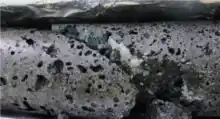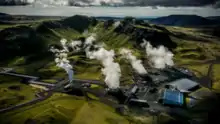| Industry | Carbon sequestration |
|---|---|
| Founded | 2007 |
| Founders | Reykjavík Energy, the University of Iceland, CNRS, and the Earth Institute at Columbia University |
| Headquarters | , |
| Website | https://www.carbfix.com/ |
Carbfix is an Icelandic company that has developed an approach to capturing and storing CO2 in water, and its injection into subsurface basalts. Once in the subsurface, the injected CO2 reacts with the host rock forming stable carbonate minerals, thus providing storage of the captured gas.
Approximately 200 tons of CO2 were injected into subsurface basalts in 2012. Research results published in 2016 showed that 95% of the injected CO2 was solidified into calcite within 2 years, using 25 tons of water per tonne of CO2.[1][2][3] Since this time this approach has been upscaled at Hellisheiði and ongoing research is implementing this approach at other sites across Europe.
Background
Carbfix was founded by the then Icelandic President, Dr Ólafur Ragnar Grímsson, Einar Gunnlaugsson at Reykjavík Energy, Wallace S. Broecker at Columbia University, Eric H. Oelkers at CNRS Toulouse (France), and Sigurður Reynir Gíslason at the University of Iceland to limit the Greenhouse gas emissions in Iceland.[4] Reykjavik Energy supplied the initial funding for Carbfix. Further funding has been supplied by The European Commission and the Department of Energy of the United States. In addition to finding a new method for permanent carbon dioxide storage, another objective of the project was to train scientists.[5]
Method

CO2 is captured either by its dissolution in water from power plant exhaust, or directly from the atmosphere by air capture followed by its dissolution in water. The carbonated water is injected into the subsurface where it reacts with the Ca and Mg present in the rock.[6] Calcium and magnesium are present in rocks - but rarely as oxides where the reactions would be simply:
- CaO + CO2 → CaCO3
- MgO + CO2 → MgCO3
However silicate minerals of these elements are common in many rocks, such as basalt, so an example reaction might be:
- Mg2SiO4 + 2CO2 → 2MgCO3 + SiO2
as a result CO2 is locked away with no dangerous byproducts.
Practicalities
Drilling and injecting carbonated water at high pressure into basaltic rocks at Hellisheiði has been estimated to cost less than $25 a ton.[7]
This project commenced carbon injection in 2012.[1][8][9][10] The funding was supplied by the University of Iceland, Columbia University, France's National Centre of Scientific Research, the United States Department of Energy, the EU, Nordic funds and Reykjavik Energy.[8]
These funding sources include the European Union's Horizon 2020 research and innovation programme under grant agreements No. 764760 and 764810. The European Commission through the projects CarbFix (EC coordinated action 283148), Min-GRO (MC-RTN-35488), Delta-Min (PITN-GA-2008-215360), and CO2-REACT (EC Project 317235). Nordic fund 11029-NORDICCS; the Icelandic GEORG Geothermal Research fund (09-02-001) to S.R.G. and Reykjavik Energy; and the U.S. Department of Energy under award number DE-FE0004847.
Cost is around US$25 per tonne of CO2.[11]
Challenges
This approach requires substantial water and the presence of reactive rocks, which are not available in all localities.
The nearby Hengill volcano, generated a swarm of low magnitude earthquakes as a result of pumping water without the CO2, with 250 quakes being reported on 13 September 2011.[12]
There have been earthquakes reported due to the injection of waste water in the area.[13][14] Proceedings at the 2010 World Geothermal Congress reported that reinjection at Hellisheiði had induced seismic activity.[15]
Criticisms
In March 2023, Carbfix was criticised in the Icelandic media when Mannlíf, an electronic news publication, revealed that the partnership's head of communications had been an outspoken climate change denialist. Ólafur Teitur Guðnason, Carbfix's principal media spokesperson, worked as a columnist for Viðskiptablaðið, an Icelandic right-wing newspaper, during the years 2004–2007. In his articles, Ólafur Teitur had expressed doubts that climate change was caused by human actions and maintained that media coverage of environmental affairs was fearmongering.[16] Ólafur Teitur replied with a Facebook post, stating that his former position was wrong and he had changed his mind since then: "I would find it burdensome if my earlier views would cast aspersions to the great work done by my colleagues at Carbfix since 2007."[17][18] In a follow-up piece, Mannlíf claimed that Ólafur Teitur's columns had all the characteristics of fake news, presenting propaganda and pseudoscience as scientific facts.[19]
Current status

Carbfix was updated, as part of the EC funded CarbFix2 project starting in June 2014 at the Hellisheiði geothermal power plant. CarbFix2 was designed to capture all of the hydrogen sulfide and most of the carbon dioxide generated from the power plant. As of 2018, 68% of the H2S and 34% of the CO2 is being captured as a dissolved phase in water and injected to a depth of 750 metres underground into basaltic rocks. Results show that the majority of these injected gases are fixed as stable mineral phases in less than one year. Further work has focused on the direct capture of CO2 from the atmosphere coupled to its subsurface mineralization.
Carbfix is currently run by a set of three scientific directors: Sigurður Reynir Gíslason of the University of Iceland, Eric H. Oelkers of the CNRS Toulouse, and Edda Sif Aradóttir of Reykjavik Energy. Current efforts are aimed at generalizing the Carbfix process in part through the use of seawater for CO2 capture and storage, so the method can be adopted worldwide.
The Carbfix approach is currently being adopted at four new sites in Europe through the EC funded GECO project.
Reykjavik Energy launched a subsidiary, Carbfix, to commercialize this technology in 2019.[20][7]
On 20 July 2021 the Swiss and Icelandic governments have agreed to jointly develop “negative emission technologies” which involve extracting CO2 from the atmosphere and storing it underground using Carbfix and Climeworks.[21]
References
- 1 2 Matter, Juerg M.; Stute, Martin; Snæbjörnsdottir, Sandra O.; Oelkers, Eric H.; Gislason, Sigurdur R.; Aradottir, Edda S.; Sigfusson, Bergur; Gunnarsson, Ingvi; Sigurdardottir, Holmfridur; Gunlaugsson, Einar; Axelsson, Gudni; Alfredsson, Helgi A.; Wolff-Boenisch, Domenik; Mesfin, Kiflom; Fernandez de la Reguera Taya, Diana; Hall, Jennifer; Dideriksen, Knud; Broecker, Wallace S. (June 10, 2016). "Rapid carbon mineralization for permanent disposal of anthropogenic carbon dioxide emissions". Science. 352 (6291): 1312–1314. Bibcode:2016Sci...352.1312M. doi:10.1126/science.aad8132. PMID 27284192.
- ↑ "Scientists turn carbon dioxide into stone to combat global warming". The Verge. Vox Media. 10 June 2016. Retrieved 11 June 2016.
- ↑ Le Page, Michael (2016-06-09). "CO2 injected deep underground turns to rock – and stays there". New Scientist. Retrieved 2017-12-04.
- ↑ Gíslason, Sigurður R.; Sigurðardóttir, Holmfriður; Aradóttir, Edda Sif; Oelkers, Eric H. (July 2018). "A brief history of CarbFix: Challenges and victories of the project's pilot phase". Energy Procedia. 146: 103–114. doi:10.1016/j.egypro.2018.07.014.
- ↑ "That CO2 warming the world: Lock it in a rock". Retrieved 11 October 2011.
- ↑ Oelkers, Eric H.; Gislason, Sigurdur R.; Matter, Juerg M. (2008-10-01). "Mineral Carbonation of CO2". Elements. 4 (5): 333–337. doi:10.2113/gselements.4.5.333. ISSN 1811-5209.
- 1 2 Gunnarsson, Ingvi; Aradóttir, Edda S.; Oelkers, Eric H.; Clark, Deirdre E.; Arnarson, Magnús Þór; Sigfússon, Bergur; Snæbjörnsdóttir, Sandra Ó.; Matter, Juerg M.; Stute, Martin; Júliusson, Bjarni M.; Gíslason, Sigurður R. (December 2018). "The rapid and cost-effective capture and subsurface mineral storage of carbon and sulfur at the CarbFix2 site" (PDF). International Journal of Greenhouse Gas Control. 79: 117–126. doi:10.1016/j.ijggc.2018.08.014.
- 1 2 "Iceland's Hellisheidi prepares to start injection at carbon storage project". 9 September 2011. Archived from the original on 2012-03-27. Retrieved 2011-09-16.
- ↑ "Carbfix project – from gas to rock - GREBE Project". GREBE project, European Union. 2017-02-19. Retrieved 2017-12-04.
- ↑ Sigfusson, Bergur; Gíslason, Sigurður R.; Matter, Juerg M.; Stute, Martin; Gunnlaugsson, Einar; Gunnarsson, Ingvi; Aradóttir, Edda S.; Sigurðardóttir, Holmfriður; Mesfin, Kiflom; Alfredsson, Helgi A.; Wolff-Beonisch, Domenik; Arnarsson, Magnus T.; Oelkers, Eric H. (June 2015). "Solving the carbon-dioxide buoyancy challenge: The design and field testing of a dissolved CO2 injection system". International Journal of Greenhouse Gas Control. 37: 213–219. doi:10.1016/j.ijggc.2015.02.022.
- ↑ "This startup has unlocked a novel way to capture carbon—by turning the dirty gas into rocks". Fortune. Retrieved 2021-12-01.
- ↑ "Water pumping causes tremor" (in Icelandic). 13 September 2011.
- ↑ "Orkuveitan framkallar jarðskjálfta í Henglinum" (in Icelandic). 21 February 2011.
- ↑ "Human made earthquakes in Hengill volcano". 21 February 2011. Archived from the original on 21 October 2011. Retrieved 15 September 2011.
- ↑ "Geothermal Reinjection at the Hengill Triple Junction, SW Iceland" (PDF). Retrieved 27 September 2011.
- ↑ "Samskiptastjóri Carbfix: „Umhverfismál eru ofmetinn málaflokkur – Yfirborð sjávar er ekki að hækka"". Mannlíf (in Icelandic). Retrieved 2023-04-03.
- ↑ "Samskiptastjóri Carbfix var efasemdamaður í loftslagsmálum". Vísir (in Icelandic). Retrieved 2023-04-03.
- ↑ "Ólafur svarar gagnrýni um fyrri efasemdir". mbl.is (in Icelandic). Retrieved 2023-04-03.
- ↑ "Sæll Ólafur Teitur: Ná sinnaskipti þín líka til annarra málaflokka?". Mannlíf (in Icelandic). Retrieved 2023-04-03.
- ↑ "Our story | Carbfix". www.carbfix.com. Retrieved 2020-07-17.
- ↑ "Switzerland and Iceland join forces to 'capture' CO2". swissinfo.ch. Archived from the original on 2021-08-02.
External links
- Carbfix.com – Website of the project
- Brabant, Malcolm (August 23, 2016). "To combat climate change, these scientists are turning CO2 into rock". PBS NewsHour. WETA-TV. Retrieved July 18, 2022.
- To combat climate change, these scientists are turning CO2 into rock on YouTube, Aug 23, 2016 PBS NewsHour